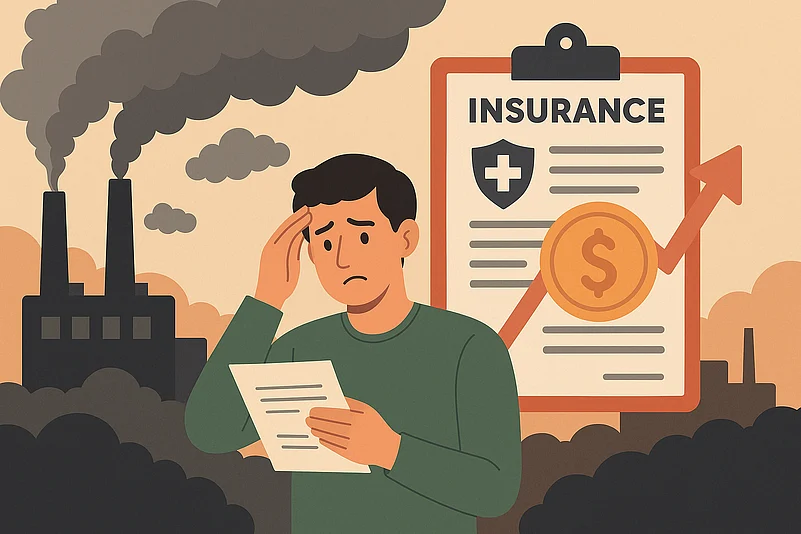Pollution Pushes Health Insurance: Health insurance in India is getting more expensive, and one of the surprising factors behind this rise is pollution-related health claims. With air quality worsening in major cities, insurers are beginning to factor in the long-term costs of treating chronic illnesses caused or aggravated by pollution. This has led to forecasts that premiums may rise by 10–15% in the coming months, putting added pressure on policyholders who are already grappling with higher medical and living costs.
In Delhi, for example, insurers reported a sharp increase in health claims during the winter months, when air quality levels dropped to alarming levels. Hospitalizations for asthma, chronic obstructive pulmonary disease (COPD), pneumonia, and other pollution-linked illnesses surged, forcing insurance companies to pass on the cost to customers. With respiratory and heart-related issues on the rise, the industry expects premium hikes to become more frequent in the years ahead.
For policyholders, this means preparing for higher renewal costs and carefully reviewing policy terms. Exclusions, sub-limits, and co-pay clauses are crucial to understand, especially when it comes to pollution-related treatments. At the same time, exploring top-up plans or group health coverage could help families manage these rising expenses without compromising on protection.
Why Pollution Is Driving Up Health Insurance Costs
Rising Claims from Pollution-Linked Illnesses
Pollution is no longer just an environmental issue; it is a significant health risk. Cities like Delhi, Mumbai, and Lucknow have reported growing cases of respiratory and cardiovascular illnesses directly linked to poor air quality. As hospital admissions rise, insurers are facing higher payouts, pushing them to adjust premiums upward.
Read about: No GST on Insurance Premiums: Big Relief or Hidden Loss for Policyholders?
Seasonal Impact in Metro Cities
Winters in northern India worsen air pollution due to factors like stubble burning and weather conditions that trap pollutants. During this period, insurers often see a surge in claims for asthma, bronchitis, and severe lung infections. The February report of a 10–15% premium hike was directly linked to these seasonal spikes.
Long-Term Disease Burden
Air pollution doesn’t just trigger temporary illnesses — it contributes to chronic conditions like COPD, hypertension, and even heart disease. Insurers anticipate a long-term financial burden from these claims, which is why they are gradually pricing in pollution risks into policy premiums.

What Policyholders Should Do
1. Review Policy Terms Carefully
Check for exclusions, sub-limits, and co-pay clauses related to pollution-linked illnesses. Some policies may only cover hospitalization, while outpatient treatments could be excluded.
2. Consider Top-Up Health Plans
If your base policy has limited coverage, a top-up plan can provide additional financial protection at a relatively lower cost.
3. Explore Group Health Coverage
Employees should evaluate whether their company’s group health insurance can complement personal coverage, especially in high-pollution regions.
4. Budget for Higher Renewal Costs
Policyholders should plan ahead and set aside funds for potential 10–15% premium hikes, especially those living in cities with consistently poor air quality.
Also read: Changan Deepal S07 Review: A Bold Chinese EV Crossover for the UK Market
Conclusion
Rising health insurance premiums linked to pollution are becoming the new reality for urban residents in India. With insurers facing increasing claims for respiratory and heart-related illnesses, policyholders must brace themselves for higher renewal costs.
While this trend may feel discouraging, it also highlights the importance of maintaining comprehensive coverage. Medical expenses for pollution-related diseases can be unpredictable and overwhelming without insurance support.
The best approach is proactive planning — reviewing your policy, exploring add-on or top-up options, and considering group coverage to balance affordability with protection. In the long run, higher premiums may be unavoidable, but being prepared ensures that you and your family remain financially secure.
As pollution continues to affect health in major cities, insurers are likely to keep factoring it into their pricing models. Policyholders who adapt early, stay informed, and optimize their coverage will be better equipped to manage these rising costs.






